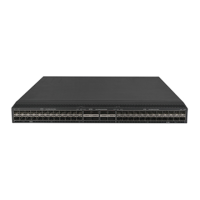5
Type Description
Management VID Management VLAN ID.
VID Usage Digest VLAN ID usage digest.
ETS Configuration Enhanced Transmission Selection configuration.
ETS Recommendation ETS recommendation.
PFC Priority-based Flow Control.
APP Application protocol.
QCN
Quantized Congestion Notification.
QCN TLVs are not supported in the current software version.
IEEE 802.3 organizationally specific TLVs
Table 5 shows the IEEE 802.3 organizationally specific TLVs.
The Power Stateful Control TLV is defined in IEEE P802.3at D1.0 and is not supported in later
versions. The device sends this type of TLVs only after receiving them.
Table 5 IEEE 802.3 organizationally specific TLVs
Type Description
MAC/PHY Configuration/Status
Contains the bit-rate and duplex capabilities of the port, support for
autonegotiation, enabling status of autonegotiation, and the current
rate and duplex mode.
Link Aggregation
Indicates whether the port supports link aggregation, and if yes,
whether link aggregation is enabled.
Power Via MDI
Contains the power supply capabilities of the port:
• Port class (PSE or PD).
• Power supply mode.
• Whether PSE power supply is supported.
• Whether PSE power supply is enabled.
• Whether pair selection can be controlled.
• Power supply type.
• Power source.
• Power priority.
• PD requested power.
• PSE allocated power.
Maximum Frame Size Indicates the supported maximum frame size.
Power Stateful Control
Indicates the power state control configured on the sending port,
including the following:
• Power supply mode of the PSE/PD.
• PSE/PD priority.
• PSE/PD power.
Energy-Efficient Ethernet Indicates Energy Efficient Ethernet (EEE).
LLDP-MED TLVs
LLDP-MED TLVs provide multiple advanced applications for voice over IP (VoIP), such as basic
configuration, network policy configuration, and address and directory management. LLDP-MED
TLVs provide a cost-effective and easy-to-use solution for deploying voice devices in Ethernet.
LLDP-MED TLVs are shown in Table 6.

